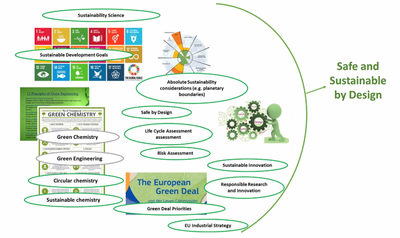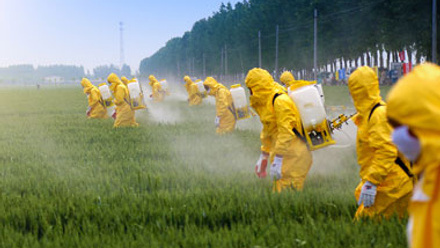SETAC–European Commission Green Deal Safe and Sustainable by Design Consultation Series and Anticipated End Products
Annegaaike Leopold, Michelle Bloor, Bruno Campos, Ksenia Groh, Leo Posthuma, Hans Sanderson, Hanna Schreiber, Paul Thomas, Organizers of the SETAC – EC Green Deal SSbD Consultation Series
The 2nd Consultation Meeting will be held online from 13:30–16:30 CET on 31 January.
As a part of the Green Deal and the Chemical Strategy for Sustainability (CSS), the Safe and Sustainable by Design (SSbD) vision embodies an important and proactive framework for assessing and managing chemicals and products, achieved by merging and innovating safety and sustainability approaches. However, the data sets needed to inform such assessments are currently often incomplete, which could be due to insufficient quality, inaccessibility or complete absence of such data at the present moment. This “data challenge” greatly limits the current use of the SSbD framework by the chemical companies who need to apply it under the emerging regulatory frameworks.

Underpinning principles and approaches informing the Safe and Sustainable by Design framework (click to enlarge)
Similarly, the concepts, methods, models and tools available to support SSbD assessments have not yet been fully agreed upon and will require further innovation and research and development efforts. Those can be aimed at identifying the solutions for current problems, such as towards further integration of environmental risk assessment and life cycle assessment (LCA), as well as either developing new approaches, or adapting or simplifying the already-existing tools and procedures in order to increase their practicability and enable broader use by subject matter experts.
In this context, the CSS-aspirations implicitly ask SETAC scientists to help identify the most important and innovative scientific approaches, data sets, data platforms and tools needed for the sound development of SSbD, as well as ultimately to further define a comprehensive SSbD roadmap.
In a series of three events co-organized with the EC, the 1st Consultation Meeting (SETAC Café) aimed to yield a brainstorm-based overview for these ambitious goals, with more than 100 suggested items. The 2nd Consultation Meeting will build on this further, following the digestion of these items into three key, cross-cutting themes (see below). Both consultation meetings are being organized by the Sounding Board for the representation of SETAC at the High-Level Round Table for the implementation of the CSS. The Seville on-site workshop in May will then aim to yield one comprehensive, aspirational roadmap to improve and broaden the science-based utility of the SSbD Framework.
Objectives and Themes
The objective of the 2nd Consultation Meeting is to closely consider the three main themes that emerged from the 1st Consultation, define what the ideal end-product of each theme would be for robust and operational SSbD and begin identifying the steps of a roadmap for each theme. Subsequently, the Seville workshop will take up these roadmap elements and integrate them into the aspirational end-product of this SETAC-consultation series: “A roadmap for innovative, robust and valuable science-based approaches for effective implementation of SSbD framework.” The Seville workshop will thus adopt the results of the 1st and 2nd Consultations and develop roadmaps per theme as well as one comprehensive roadmap. There is ample scope for SETAC scientists to become (co-)owner of one or the other theme and, ahead of the Seville workshop, contribute to the development of a particular element within this roadmap, potentially followed by the execution of the resulting project (e.g., as part of an EC-project call).
Highlights from the 1st Consultation Meeting (October 2023)
In the 1st Consultation Meeting, participants learned of the three-step approach through which SETAC scholars can assist to advance SSbD. The EC talked about the relevance of the project, and the SETAC sounding board focused on its aspirational goals. Six breakout groups of two groups per theme dealt with 1) hazard assessment, 2) risk assessment and 3) life cycle analysis questions in the context of SSbD. The participants, which numbered more than 100, listed problems and potential tracks to solutions to more than 100 issues. The participants then sorted the matters by expected short-term, quick wins, and expected middle- or longer-term research and implementation pathways.
After the 1st SETAC Café, the Sounding Board members summarized the raw results in a preliminary report, upon which they undertook a pattern-recognition exercise. That exercise was aimed at identifying cross-cutting themes, the solution of which would forward the SSbD implementation. The three themes identified were related to problems with data; assessment concepts and tools, such as the need for integrated safety and sustainability assessment; and the education and skills necessary to support the implementation of the SSbD framework.
On Data. More specifically, in all three breakout-group subjects, addressing data gaps and how to obtain access to missing data or generate them with novel assessment methods and/or artificial intelligence (AI) methods appeared as a major theme. Attendees raised ideas and suggestions, such as:
- Integrating databases into a single one, in line with the One Substance–One Assessment approach as required by the CSS
- Ranking data sources
- Contemplating a unified, up-to-date database and what it would include, for example, two containers, one containing conventional data and one containing data generated by novel approaches.
On Assessment Concepts and Tools. Where tonnage bans, grouping and the use of QSARs were important for regulatory frameworks such as REACH, the potentially developed next-generation models and tools for SSbD will take place in an era of “big data,” machine learning and artificial intelligence. These technologies were broadly recognized as becoming increasingly more important in delivering SSbD and the CSS in the years to come. Thus, the combination of data considerations (previous point) and novel concepts and tools will likely yield the solutions needed for data-poor assessments, which are at play for SSbD, especially for early stages of innovations. Moreover, tools and methods designed to support different levels of innovation will be needed to ensure a common understanding and a level playing field. In this context, SSbD in practice also asks for a responsible and robust simplification of existing techniques, especially for early-stage explorative assessments. Employing a tiered approach was seen as critical – specifically given the important role of the tens of thousands of subject matter experts, who have to employ SSbD in their daily practices.
Due to the different actors and needs in the chemicals sector, tiered and differentiated approaches will be required to meet these needs. Step four of the EC’s SSbD framework, an environmental sustainability assessment, will require further development of a tiered approach, integrating concepts known from chemical risk assessment approaches with life cycle assessments. There are good tools already available, for example, the USEtox method for aquatic toxicity, but these need to be supplemented with additional tools relevant for different levels of innovation to facilitate not only the experts’ capabilities and needs but also those of larger companies. Creative approaches are needed to encourage innovation in the selection of candidate molecules for the development of safe and sustainable chemicals, allowing the innovation process to lead to more sustainable choices with increasing data richness and robustness before ultimate release on the market.
On Education and Skills. Attendees of the breakout groups also highlighted, with different terms and emphasis, the need for education and skills. The SSbD and the CSS are valuable concepts, and they embody high aspirations, but those will stay beyond reach if suitable data and tools remain opaque for the majority of actors in the chemical sector. It was considered of paramount importance to pay attention to education and skills, which consist of cross-sectoral learning (e.g., between safety- and sustainability-experienced experts) as well as towards ground-truthing results that a better SSbD score indeed reflects lower impacts. This warrants specific attention.
Themes for the 2nd Consultation
The more than 100 participating SETAC scientists’ ideas from the 1st Consultation Meeting have led the organizers to recognize that successful approaches require data, concepts and, ultimately, operational tools and associated skills. These considerations have resulted in the decision that the 2nd Consultation meeting is organized in three a priori identified cross-cutting themes, as summarized below. However, recognizing that the problems and opportunities of the CSS are vast, the organizing team is also leaving room for a “wildcard” approach. The 2nd Consultation meeting will organize breakout groups as follows: Each group will be asked to review the current situation and look forward to an aspirational or ideal goal. The breakout groups will also be asked to define the “stepping stones” to reach that goal. The stepping stones should include, first, a brainstorm, then the sorting of ideas in a thematic roadmap outline. Note that the Seville workshop will adopt those to develop an overarching comprehensive roadmap, with a goal to link all themes.
Data and Methods
Data gaps exist for both safety and sustainability assessments. The aspirational goal would be to address all these. This covers, but is not limited to, the question of how to obtain access to missing data, approaches to ranking data sources, contemplating a unified data base for each metric, and finally applying artificial intelligence and machine learning methods to bridge data gaps.
Concepts and Models
Multiple concepts, methods, models and indicators exist in the realms of safety and sustainability assessment, and those are combined in the SSbD framework. The aspirational goal – assuming that data problems will be solved – would be to comprehensively align and successively improve the existing concepts and methods from all realms, so that they can provide useful SSbD insights in the various development stages of a chemical or product. This covers, but is not limited to, collating existing concepts, models and tools; identifying opportunities to align them across safety and sustainability; defining opportunities to simplify, particularly for early Technological Readiness Levels (TRL), i.e., tiering; and finding opportunities to accommodate AI-based data.
Tools, Tier Schemes, Skills and Education
Science-based approaches in SSbD can be complex to understand, handle or combine and interpret, especially for early stages. The aspirational goal would be to recognize and collate science-based data and concepts that can be shaped into tiered tools (for lower to higher TRLs), in conjunction with providing proper training of skills and necessary education, so that the SSbD framework can be adopted and used effectively under many conditions.
Wildcard
If so desired, the 2nd SETAC Cafe can have a breakout on a subject identified by the attendees. Such a wildcard breakout can provide valuable additional insights in matters that are considered valuable by the attendees and that might develop into a valuable thematic roadmap.
We provide one example of a set of suggestions that could develop into a specific wildcard breakout that is based on the results of the LCA breakout groups from the 1st Consultation Meeting.
- Observation: A game changing proposal from the LCA breakout groups was a suggestion to define and employ spatialized ecological boundaries for chemical pollution as potentially relevant aspiration for SSbD.
- Aspirational ideal development: Benchmarking the ecological impact of new material against ecological targets would require the consideration of:
- The total amount of chemical pollution as background
- The regional differences in ecological capacity to dilute chemical pollution
- The extrapolation, or scaling up of impacts, to market-level
- And, that such boundaries would have to be quantitative and comparative, consistent with the Planetary Boundaries framework as well as with LCA boundary conditions
- The Wildcard-breakout would define this as a key subject, define a future goal and discuss which matters are most critical to developing the goal.
Before entering into the breakout groups, speakers from SETAC and the EC will introduce key matters, discuss the simultaneous but different developments in the Partnership for the Assessment of Risks from Chemicals program, and review the development of the roadmaps that are the aim of the SETAC–EC collaboration.
The 2nd Consultation Meeting will be held from 13:30–16:30 CET on 31 January. Learn more about the event or register today.
Author’s contact: [email protected]





